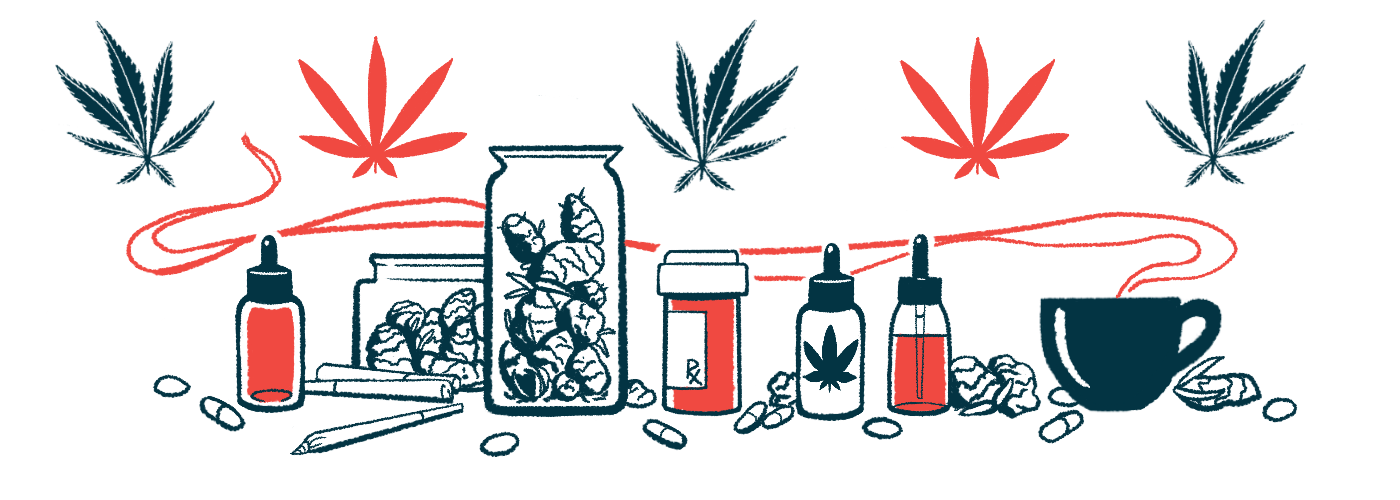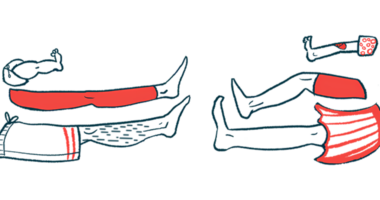Nabiximols, cannabis-based spray, eases spasticity in real-world use
Most adults in small study report less stiffness, better sleep and pain levels

Nabiximols, a cannabis-based oral spray sold as Sativex, was reported to considerably ease spasticity — unusual muscle tightness or stiffness — in about two-thirds of the multiple sclerosis (MS) patients using it for three months in a real-world study in Germany.
For most patients, the treatment also eased pain and improved walking ability and sleep. After three months, about 62% of the study’s 51 evaluated patients reported that nabiximols’ use met their treatment goals “as expected” or “better than expected.”
“Nabiximols may be useful for MS patients with a poor response to usual spasticity medications,” researchers wrote in “Patient-reported benefits from nabiximols treatment in multiple sclerosis-related spasticity exceed conventional measures,” which was published as a short communication in Future Medicine.
Nabiximols, sold as Sativex, is available in Europe and Canada
Nabiximols is an oral spray that contains an equal amount of delta-9 tetrahydrocannabinol (THC) and cannabidiol (CBD), the main active compounds found in the cannabis plant. It is used as an add-on treatment to relieve muscle stiffness and spasms in patients who do not get enough relief with other spasticity medications.
Developed by GW Pharmaceuticals, now part of Jazz Pharmaceuticals, the medication is approved in most countries in Europe and in Canada, but not in the U.S.
Evidence has shown that nabiximols is an effective add-on option to ease spasticity and associated common MS symptoms, such as pain and sleep problems. But questions remained as to whether the medication’s effects are sufficient to meet patient expectations.
To find out, a team of researchers across Germany examined the responses of 54 adults with MS who started treatment with nabiximols in routine clinical practice. Participants also were asked about their individual treatment goals.
In countries where it’s approved, nabiximols generally is given for long-term use only to patients who demonstrate a meaningful improvement in spasticity in an initial treatment period. This approach, ensuring nabiximols is given to those who are expected to benefit, also was employed by the researchers but not as strictly.
Most patients in study found MS spasticity treatments ineffective or intolerable
Of the 54 patients, 49 (90.7%) experienced a 20% or greater reduction in spasticity scores after a four-week trial period, and were eligible to continue treatment. Of the five who failed to respond, two still continued using nabiximols.
As such, 51 adults were treated with nabiximols for up to 12 weeks (about three months). Their mean age was 51.4, most (60.8%) were women, and they had been diagnosed with MS a mean of 14.9 years earlier. Their median Expanded Disability Status Scale score at the study’s start was 4, indicating significant disability but an ability to walk.
Most patients (86.3%) had used spasticity medications, but they either had an inadequate response or could not tolerate them.
To better understand patients’ individual goals and the extent to which they were achieved with treatment, researchers used the Goal Attainment Scale (GAS). Participants were asked to selected five goals and to rate their responses based on their expectations.
Overall, the most frequent treatment goals were reduced pain (68.6%), improved walking (52.9%), and better sleep (49%). Other goals included less discomfort caused by muscle stiffness, greater ease in climbing stairs, a better range of movement, and reduced fatigue.
At the end of treatment, 62.2% of these individual goals had been achieved. For about two-thirds of patients, goals were met as expected (28%), more than expected (15.1%), or much more than expected (19.1%).
Average GAS scores increased by about 46% over this time, rising from 35.2 to 51.4 points. Overall GAS scores range from zero to 100 points, with higher values indicating a better outcome.
“The positive change in GAS scores indicates that the benefits of nabiximols extend beyond a nonspecific enhancement in quality of life or wellbeing as per a ‘lifestyle’ drug,” the scientists wrote.
Easing of spasticity, walking issues reported at 4 and 12 weeks of treatment
The severity of spasticity, evaluated by a physician-rated scale ranging from zero (no impairment) to 10 (the worst imaginable impairment), decreased by an average 23.2% after four weeks. Patients also reported a 45.5% reduction in spasticity after four weeks and 52.7% after 12 weeks of treatment, with improvements in walking abilities at both time points.
Most of the 29 patients who answered the Patient’s Global Impression of Change in Spasticity questionnaire reported that their spasticity was “very much” (13.8%) or “much” (65.5%) improved after 12 weeks.
Patients also reported less spasticity-related pain, better sleep, and fewer bladder problems. “Meaningful improvements were recorded in spasticity-related symptoms of pain, sleep quality and bladder problems,” the researchers wrote.
Nabiximols, at both four and 12 weeks, was used at a mean daily dose of 5.3 and 5.9 sprays the researchers noted, “similar to doses reported in other real-world studies” of the treatment.
Side effects were mild to moderate, and included fatigue, dizziness, balance problems, heart failure, and mood swings. Seven patients (13.7%) stopped using nabiximols due to side effects.
“Nabiximols appears to be a useful therapeutic option for patients with MS spasticity who have inadequate relief of spasticity-related symptoms with conventional antispasticity therapy or who poorly tolerate conventional antispasticity therapy,” the researchers concluded.







